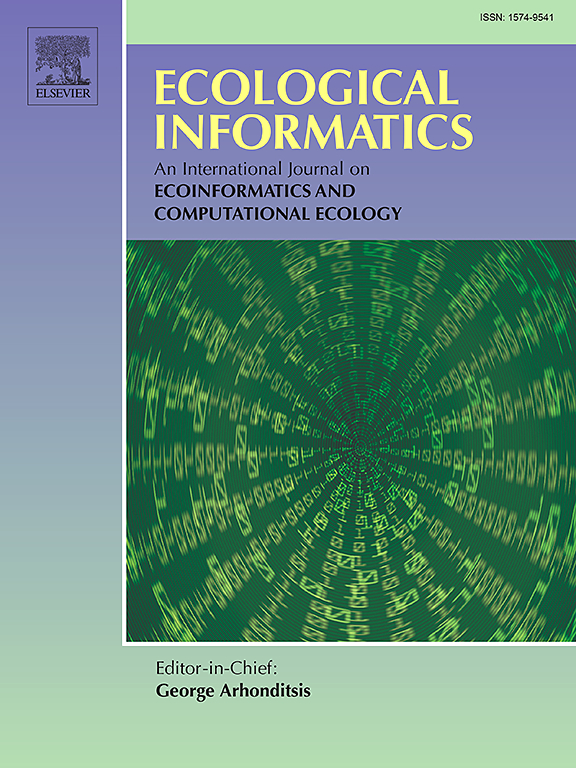混浊温带水域石礁图像自动分类的纹理描述符评价
IF 7.3
2区 环境科学与生态学
Q1 ECOLOGY
引用次数: 0
摘要
机器学习(ML)技术的兴起使得自动图像分类对海洋生物学家来说越来越重要。尽管计算能力的进步和对该领域的兴趣日益浓厚,但水下图像分析仍然是一个重大挑战,特别是在高度浑浊的环境中。这项研究首次评估了纹理描述符在使用浑浊水下图像对底栖生物物种和栖息地进行分类方面的潜力。使用下拉式摄像机采集波罗的海东南部珊瑚礁(深度4.4-42.2 m)的水下图像。总共测试了16个纹理描述符,其中选择了3个用于CatBoost ML模型图像分类任务。使用现场专家提供的注释图像来评估模型的性能。其中,MRELBP (Median Robust Extended Local Binary Pattern)算法的综合性能最高。在单个分类中,LMP (Local Morphological Pattern)算法对大蓝贻贝的F1评分为0.72±0.18,MRELBP算法对小蓝贻贝的F1评分为0.66±0.13。对于岩性分类,MRELBP对砂岩的分类精度最高(F1得分:0.69±0.23)。模型覆盖率估计在49%的图像中是可接受的,蓝贻贝是最适合评估的。结果证明了纹理描述符在真实世界水下图像分类中的能力。本文章由计算机程序翻译,如有差异,请以英文原文为准。
Evaluating textural descriptors for automated image classification of stony reefs in turbid temperate waters
The rise of machine learning (ML) techniques has made automatic image classification increasingly relevant and essential for marine biologists. Despite advancements in computational power and growing interest in the field, underwater image analysis remains a significant challenge, especially in highly turbid environments. This study is the first to assess the potential of texture descriptors for classifying benthic species and habitats using turbid underwater imagery. Underwater images were collected in SE Baltic Sea reefs (4.4–42.2 m depth) using a drop-down camera. A total of sixteen textural descriptors were tested, of which three were selected for the CatBoost ML model image classification task. The model's performance was evaluated using annotated images provided by field experts. Among these, the MRELBP (Median Robust Extended Local Binary Pattern) algorithm achieved the highest overall performance. For individual classes, the best image classification results were achieved for large blue mussels by the LMP (Local Morphological Pattern) algorithm (F1 score: 0.72 ± 0.18) and small blue mussels (F1 score: 0.66 ± 0.13) by MRELBP. For lithological classes, sand was classified with the highest accuracy by MRELBP (F1 score: 0.69 ± 0.23). Model coverage estimates were acceptable in 49 % of the images, with blue mussels being the most suitable for evaluation. The results demonstrate textural descriptors capabilities in classifying real-world underwater images.
求助全文
通过发布文献求助,成功后即可免费获取论文全文。
去求助
来源期刊

Ecological Informatics
环境科学-生态学
CiteScore
8.30
自引率
11.80%
发文量
346
审稿时长
46 days
期刊介绍:
The journal Ecological Informatics is devoted to the publication of high quality, peer-reviewed articles on all aspects of computational ecology, data science and biogeography. The scope of the journal takes into account the data-intensive nature of ecology, the growing capacity of information technology to access, harness and leverage complex data as well as the critical need for informing sustainable management in view of global environmental and climate change.
The nature of the journal is interdisciplinary at the crossover between ecology and informatics. It focuses on novel concepts and techniques for image- and genome-based monitoring and interpretation, sensor- and multimedia-based data acquisition, internet-based data archiving and sharing, data assimilation, modelling and prediction of ecological data.
 求助内容:
求助内容: 应助结果提醒方式:
应助结果提醒方式:


